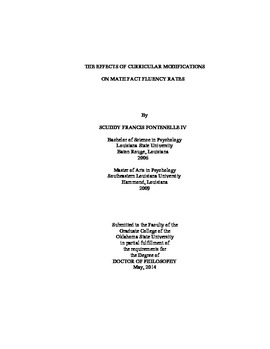| dc.description.abstract | The current investigation compared the instructional efficiency of an explicit timing intervention between three conditions that varied on the curricular dimension of problem set size. The first goal was to determine if learning rates differ between groups exposed to probe sets containing either a mixture of automatic and non-automatic multiplication problems (Total Condition), non-automatic multiplication problems (Reduced Condition), or a specific ratio of automatic to non-automatic multiplication problems (Ratio Condition). A second goal was to determine if student performance would generalize on 36-problem Reciprocal probe sets. A third goal was to determine which instructional condition facilitates the maintenance of multiplication fact fluency performance the greatest over time. Participants included 73 fourth grade students attending general education at a public school in north central Oklahoma. Student performance was assessed pre-intervention (pre-test), following five weeks of intervention implementation (i.e., posttest), and two weeks following intervention cessation (i.e., maintenance). The total number of digits answered correctly per minute (DCPM) determined fluency performance on each dependent measure (i.e., 100-problem, 36-problem reduced, and 36-problem reciprocal assessments). A doubly repeated-measures multivariate analysis of variance (MANOVA) was utilized and consisted of one within subjects factor (i.e., Pretest, Posttest, and Maintenance) and one between subjects factor (i.e., Total, Reduced, and Ratio Conditions). Collectively, the results indicated that explicit timing was an effective intervention for improving the multiplication fluency performance of students in all treatment conditions. In addition, scores on a two-week follow-up assessment indicated that student fluency performance remained relatively stable over time. The lack of a significant Group x Time interaction suggested the fluency performance of students in each group was similar on multiple assessments over time (i.e., Pretest, Posttest, and Maintenance) on each dependent measure (i.e., 100-problem, 36-problem reduced, and 36-problem reciprocal Assessments). However, the absence of the significant interaction indicated that student fluency performance generalized to the novel presentation of multiplication facts (i.e., reciprocals) for specific conditions. | |
